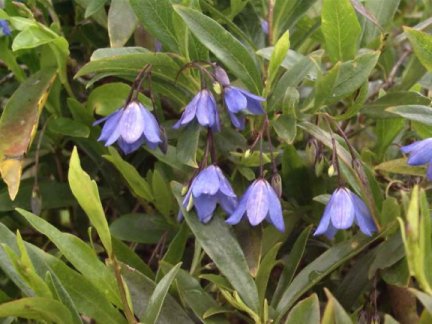

Sollya Heterophylla - Richard Horsman Solly
From George Solly
This article was originally published in the December 2000 edition of Soul Search, the journal of The Sole Society.
 No-one
could fail to be flattered to have a plant named in their honour, but some
plants are more attractive than others. Imagine, then, the delight that the
British plant physiologist Richard Horsman Solly must have felt in about
1830, when he first saw one of the two species on the genus that was given his
name, Sollya Heterophylla. Commonly called the Bluebell Creeper or Australian
Bluebell, it is a charming plant.
No-one
could fail to be flattered to have a plant named in their honour, but some
plants are more attractive than others. Imagine, then, the delight that the
British plant physiologist Richard Horsman Solly must have felt in about
1830, when he first saw one of the two species on the genus that was given his
name, Sollya Heterophylla. Commonly called the Bluebell Creeper or Australian
Bluebell, it is a charming plant.
The bluebell creeper, as its name suggests, is a slender twining plant found in the wild in Australia, scrambling through shrubs to a height of 2-3m (6-10ft) or loosely covering the ground at about 30cm (12in).
It is evergreen, with leaves of variable size and shape, hence its name heterophylla, meaning various-leaved. A single plant can look rather different at certain stages of growth or under differing cultural conditions.
 The
startling sky-blue flowers are its crowning glory, and are freely produced from
April to September. The flowers are shaped like the skirt of a crinolined
ballgown, with a minute calyx and five broad, overlapping petals about 1cm long.
Each petal can reportedly be peeled into two layers, like a 2-ply tissue.
The
startling sky-blue flowers are its crowning glory, and are freely produced from
April to September. The flowers are shaped like the skirt of a crinolined
ballgown, with a minute calyx and five broad, overlapping petals about 1cm long.
Each petal can reportedly be peeled into two layers, like a 2-ply tissue.
For those in the UK, it is a delicate shrub ideally needing greenhouse protection. However, in sheltered urban gardens or warmer areas of the UK it can survive outside, scrambling through an evergreen shrub or cascading down from the top of a wall.
Extracted from an article by Adrian Whiteley, a botanist at the RHS Garden Wisley, UK
Return to The Sole Society Home Page